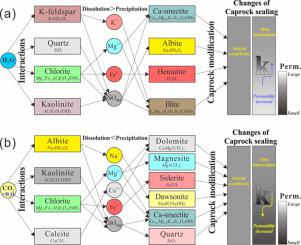International Journal of Greenhouse Gas Control ( IF 3.9 ) Pub Date : 2023-02-18 , DOI: 10.1016/j.ijggc.2023.103860 Xin Ma , Yujie Diao , Lei Fu , Jing Yan , Guodong Yang , Chenglong Zhang , Siyu Liu , Hanchuan Dong , Ying Yu

|
This study investigates the influence of geochemical reactions among CO2, water and key minerals on caprock sealing using laboratory experiments and numerical simulations, based on mudstone caprock of the Triassic Heshanggou Formation at the Shenhua CCS demonstration project in Ordos Basin. The results show that there is an obvious dissolution occurring in caprock after long-term water-rock interactions without CO2 injection, with a maximum increase of 11% in caprock permeability. The dissolution of kaolinite, chlorite, K-feldspar and quartz results in the increase of caprock permeability, and the precipitation of illite and hematite is the key factor effectively slowing down the change of permeability. However, the self-sealing capability of the caprock is continuously enhanced under the condition of CO2 injection, with permeability reduced by 40% of the original permeability at maximum. The precipitation of carbonate minerals directly induces the change of caprock permeability, and the precipitation of Ca-smectite and quartz further promotes the caprock sealing. Dolomite, siderite, magnesite and dawsonite are the key CO2 trapping minerals for the enhancement of caprock sealing, and the maximum amount of CO2 trapped in mineral phase is 35.44 kg/m3 medium. The dissolution of albite, chlorite and calcite provides the necessary Na+, Mg2+, Ca2+ and Fe2+ for the precipitation of carbonate minerals, which is conducive to the enhancement of caprock sealing, while chlorite and calcite are the key minerals affecting the caprock sealing. The dissolution of K-feldspar is not conducive to the enhancement of caprock sealing. This study could provide a theoretical basis for selection of reservoir-caprock and safety evaluation of CO2 geological storage.
中文翻译:

鄂尔多斯盆地三叠系河上沟组水-盖层和CO2-水-盖层地球化学反应对比
本研究以鄂尔多斯盆地神华CCS示范工程三叠系河上沟组泥岩盖层为背景,通过室内实验和数值模拟研究CO 2 、水和主要矿物之间的地球化学反应对盖层封闭性的影响。结果表明,在没有CO 2的情况下,盖层在长期的水岩作用下发生了明显的溶蚀作用注入,盖层渗透率最大增加 11%。高岭石、绿泥石、钾长石和石英的溶蚀导致盖层渗透率增加,伊利石和赤铁矿的析出是有效减缓渗透率变化的关键因素。但在注入CO 2的条件下,盖层自封闭能力不断增强,渗透率最多下降40%。碳酸盐矿物的析出直接引起盖层渗透率的变化,钙蒙脱石和石英的析出进一步促进盖层封闭。白云石、菱铁矿、菱镁矿和片钠铝石是关键的 CO 2圈闭矿物以加强盖层封闭,矿物相中CO 2的最大圈闭量为35.44 kg/m 3介质。钠长石、绿泥石和方解石的溶解为碳酸盐矿物的析出提供了必要的Na +、Mg 2+、Ca 2+和Fe 2+,有利于加强盖层封闭,而绿泥石和方解石是关键矿物影响盖层密封。钾长石的溶蚀不利于盖层封闭性的增强。该研究可为储盖层选型及CO 2地质封存安全评价提供理论依据。


























 京公网安备 11010802027423号
京公网安备 11010802027423号